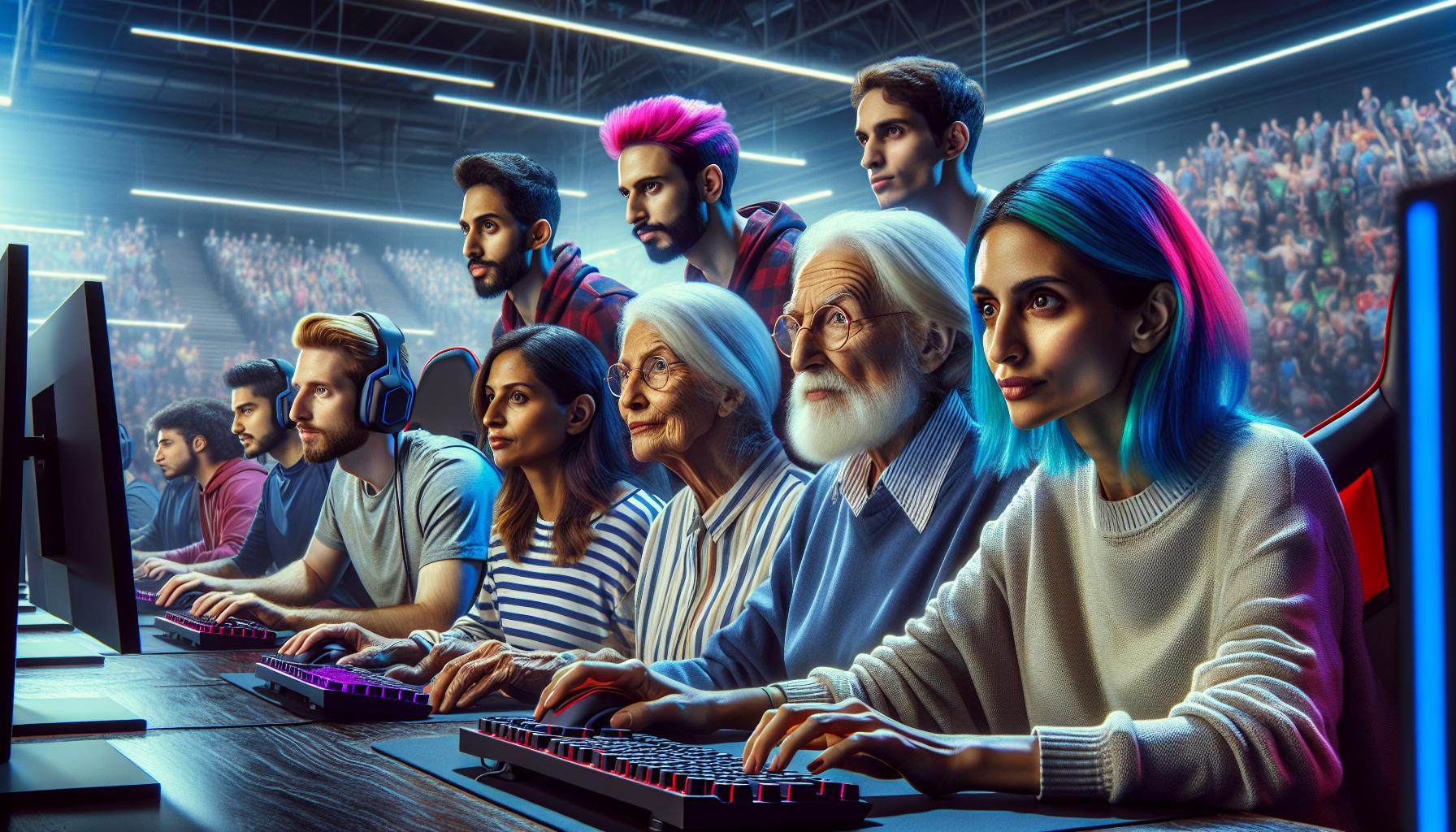Esports has exploded in popularity, transforming from niche competitions into mainstream entertainment. Amid this growth, User-Generated Content (UGC) esports is carving out a unique space. It’s not just about professional players anymore; everyday gamers are stepping into the spotlight, creating their own tournaments and content that captivates audiences.
I’ve seen firsthand how UGC esports fosters community engagement and creativity. Players are no longer just participants; they’re content creators, influencers, and event organizers. This shift is reshaping the landscape, making esports more accessible and inclusive. Join me as I explore how UGC esports is changing the game and what it means for the future of competitive gaming.
Key Takeaways
Rise of UGC Esports: User-Generated Content (UGC) esports empowers everyday gamers to create their own tournaments and content, transforming the traditional gaming landscape.
Community Engagement: Active participation in content creation fosters community bonds, promoting collaboration, interaction, and a sense of belonging among players.
Inclusive Participation: UGC esports opens doors for players of all skill levels to engage in competitions, encouraging creativity and diverse gameplay styles without traditional barriers.
Influencer Impact: Gamers are transitioning into influencer roles, significantly shaping trends, player engagement, and the promotion of lesser-known games in the esports ecosystem.
Diverse Gaming Platforms: Platforms like Twitch and YouTube are essential for UGC esports, allowing gamers to share content and connect with broader audiences, enhancing visibility for unique gaming perspectives.
Future Trends: The future of UGC esports will focus on enhanced accessibility, community-driven events, innovative monetization models, and increasing inclusivity, supported by advancements in technology and ongoing engagement.
Ugc Esports
UGC esports represents a significant shift in the competitive gaming landscape. This phenomenon involves players creating their own content, such as gameplay videos, streaming sessions, and organized tournaments. As a result, the gaming community has grown more dynamic and interactive.
I’ll highlight some key elements defining UGC esports:
- Content Creation: Gamers produce videos, tutorials, and streams that showcase their skills or experiences. These contributions enhance the overall gaming culture and attract wider audiences.
- Community Involvement: Players participate in organizing events, leading to a more inclusive environment. This strategy empowers fans to engage directly, fostering a sense of belonging.
- Diverse Platforms: Platforms like Twitch and YouTube serve as hubs for UGC esports. These sites allow gamers to broadcast their gameplay or share unique content easily.
- Influencer Impact: Many gamers have transitioned into influencer roles. This change promotes not only their favorite games but also influences trends and player engagement.
- Accessibility: UGC esports breaks down barriers for aspiring gamers and creators. Anyone can engage, allowing for diverse contributions that enrich the community.
UGC esports drives innovation, and I see it as a crucial factor in the evolution of competitive gaming.
Key Features of UGC Esports

UGC esports showcases several distinctive features that set it apart from traditional competitive gaming. These elements foster growth, innovation, and an inclusive environment within the gaming community.
Community Engagement
Community engagement serves as a cornerstone of UGC esports. Gamers actively participate by creating content and sharing experiences, which strengthens bonds among players. Events such as community-driven tournaments generate excitement and involve fans directly, encouraging collaboration and interaction. Platforms like Discord and social media enhance engagement through discussions and fan interactions. As community members contribute ideas and feedback, they help shape the esports landscape, fostering a sense of belonging.
Competitive Structure
The competitive structure of UGC esports differs from conventional models. It’s characterized by an open format that encourages anyone to participate, regardless of skill level. Players can create and organize their own tournaments, leading to a dynamic and diverse competitive environment. Rankings rely on player-generated content and community voting instead of traditional league systems. This structure allows for a wide variety of gameplay styles and formats, enticing players to explore new strategies and foster creativity within the competitive scene.
Popular Games in UGC Esports

UGC esports thrives on a variety of game genres, each attracting unique communities and fostering creative content production. The following sections detail the genres and notable titles that stand at the forefront of this vibrant gaming landscape.
Game Genres
- Battle Royale: Popularized by titles like Fortnite and Apex Legends, this genre emphasizes survival and competition in large-scale settings. Players engage in fast-paced matches, often creating tutorials and highlight reels.
- First-Person Shooters (FPS): Games like Call of Duty and Valorant dominate the UGC scene. Their emphasis on skill and strategy invites players to create tutorials and exciting gameplay montages.
- Multiplayer Online Battle Arena (MOBA): Titles such as League of Legends and Dota 2 foster complex gameplay strategies, leading to extensive community engagement through guides and content creation focused on character roles and tactics.
- Sports Simulation: Games like FIFA and NBA 2K celebrate real-world sports, encouraging users to create custom tournaments and showcase player skills through highlight videos.
- Creative Sandbox: Minecraft and Roblox allow players to design their own worlds and experiences. This genre inspires innovative projects and collaborative events, often capturing the creativity of the UGC community.
| Title | Genre | Key Features |
|---|---|---|
| Fortnite | Battle Royale | Building mechanics, frequent updates, dynamic events |
| Apex Legends | Battle Royale | Character abilities, team-based gameplay, fast-paced matches |
| Call of Duty | First-Person Shooter | Varied game modes, competitive multiplayer, extensive customization |
| Valorant | First-Person Shooter | Tactical gameplay, character classes, professional scene |
| League of Legends | MOBA | Team strategy, diverse characters, esports leagues |
| Dota 2 | MOBA | Detailed mechanics, community events, international tournaments |
| FIFA | Sports Simulation | Realistic gameplay, online competitions, licensing partnerships |
| NBA 2K | Sports Simulation | Custom tournaments, player modes, community-driven content |
| Minecraft | Creative Sandbox | Building possibilities, modding community, diverse gameplay styles |
| Roblox | Creative Sandbox | User-generated content, wide range of game types, strong community engagement |
These genres and titles not only shape the UGC esports landscape but also illustrate how players adapt and engage within these gaming experiences, driving content creation and community involvement.
Impact of UGC Esports on the Gaming Community

UGC esports cultivates a vibrant ecosystem that significantly influences the gaming community. Gamers become creators through gameplay videos, streams, and tournaments, directly impacting engagement. Enhanced community interaction fosters meaningful connections among players, breaking down barriers between creators and audiences.
Community-driven initiatives improve involvement. For example, platforms like Discord host tournaments and events, allowing players to collaborate and share strategies. This participation nurtures a sense of belonging and encourages collective growth within the gaming community.
Diverse platforms amplify visibility for underrepresented voices. Content on Twitch and YouTube showcases unique gameplay styles and perspectives, appealing to a broad audience. This inclusiveness promotes a diverse gaming culture where ideas and creative expressions flourish.
Influencers play a key role in shaping trends and preferences within UGC esports. Their endorsements can elevate lesser-known games and bring attention to niche genres, guiding community interests. This dynamic can significantly shift the landscape, pushing developers to innovate and adapt to players’ desires.
Accessibility remains pivotal in UGC esports, as aspiring gamers can enter competitive spaces without traditional gatekeeping. The open format allows players of all skill levels to participate, creating opportunities for growth and talent discovery within the ranks. This flexibility empowers individuals and strengthens the community as a whole.
Future of UGC Esports
UGC esports is poised for remarkable growth, shaping the future of competitive gaming. As technology evolves and gaming communities expand, several key trends will drive this transformation.
- Enhanced Access to Tools: Developers are increasingly providing tools for content creation, enabling more players to produce high-quality videos and streams. Platforms are becoming user-friendly, reducing the technical barriers that previously limited many potential creators.
- Growth of Community-Driven Events: Community-driven tournaments and events will continue to flourish. Platforms like Discord will host an increasing number of competitions, allowing players to connect, compete, and collaborate outside traditional structures.
- Expansion of Diverse Genres: Diverse genres will further thrive within UGC esports, attracting varied audiences. As new games emerge across various genres, the growth of communities around these games will foster unique content that resonates with players.
- Influencer Partnerships: Influencers will play a pivotal role in promoting UGC esports. Their ability to engage large audiences will help spotlight emerging games and creators. Collaborations between developers and influencers will continue to enhance visibility and interest in UGC esports initiatives.
- Innovative Monetization Models: Unique monetization models, such as crowdfunding and content subscription, will gain traction. Creators will leverage platforms like Patreon or Twitch to receive support directly from their audiences, enabling them to invest more time and resources into their channels.
- Increased Inclusivity: UGC esports will emphasize inclusivity, promoting representation within gaming. Community-driven initiatives will create spaces for underrepresented players and creators, fostering a broader spectrum of voices and perspectives within the scene.
- Integration of Virtual Reality (VR): The integration of VR technology will revolutionize UGC esports. Players will engage in more immersive environments, encouraging innovative gameplay and content creation that shifts the competitive landscape.
- Sustainability of Ecosystem: The sustainability of the UGC esports ecosystem hinges on continuous engagement and support from players, developers, and sponsors. Long-term partnerships will mark a commitment to fostering community growth and innovation in the space.
Overall, the future of UGC esports is vibrant and promising, marked by innovation, community engagement, and accessibility. The landscape will continue to evolve, reflecting the dynamic nature of gaming and the creative potential of its players.
UGC Esports is Reshaping The Competitive Gaming
UGC esports is reshaping the competitive gaming landscape in exciting ways. I’ve witnessed firsthand how everyday gamers are stepping up as creators and organizers, fostering a vibrant community. This shift not only enhances engagement but also opens doors for diverse voices within the gaming world.
As we move forward, I’m eager to see how innovations in content creation tools and community-driven events will continue to evolve. The future looks bright with increased accessibility and inclusivity paving the way for a richer gaming culture. UGC esports is more than a trend; it’s a movement that invites all of us to be part of something bigger.